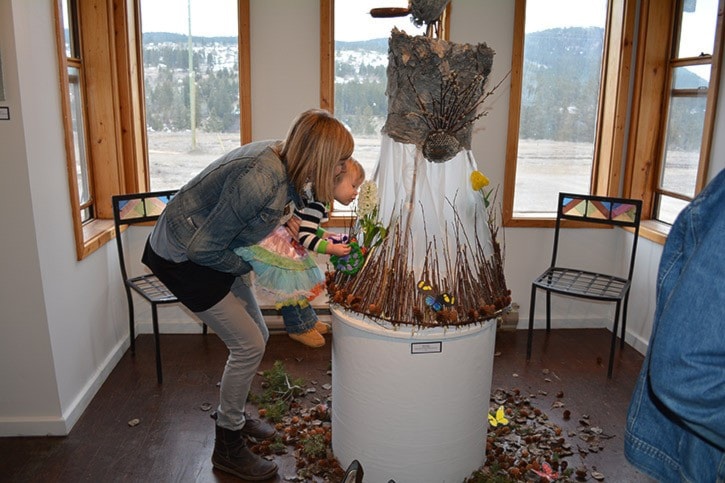By Gaeil Farrar
and Monica Lamb-Yorski
Fashion trends come and go but clothing takes on a whole new meaning with the Station House Gallery’s April show What to Wear?
The sub-line says it all — “Where Art, Fashion and Stories Collide.”
Liliana Dragowska, Beth Holden, Jane Wellburn, and special guests Leah Selk and Stephanie Bird have staged an exhibition to rival any avant guard New York or London catwalk.
Some of the pieces are obviously not wearable but from the eclectic shoes and boots hanging from the ceiling to the kindling (yes wood) jacket, funky felted dresses, a VHS recording tape hat, to the flower-shirred, shower-curtain skirt flowing into a bodice made of wasp nest fibre and cardboard, this is one unique show.
The age old question of what to wear inspired these local artists to look for answers that challenge comfort levels and spark creativity exercised in all sorts of mediums — installations, felting, sewing, glass work, stencilling, photography, up-cycling, social commentary, sound, and even poetry.
From renovating thrift store finds to experimenting with original garment design through sewing, felting, and costume making this exhibition brings the artistic talents together of these women together in one space, exploring their diverse voices, opinions and flavours, their statement says.
“With each step of the clothing life cycle potential environmental and occupational hazards are being created,” their statement says.
“Maybe we should look to the dumps as our new shopping malls and slow the effects down!”
Each of the participating artist has been exploring art in fashion and design for a number of years.
Dragowska’s preferred medium is wool most often in the form of felting.
“The one thing that is predictable is that wool breaths, it’s anti-microbial, it’s water repellent, it’s light and it had a memory to assist with holding its shape,” Dragowska says in her biography.
“Almost as if it has a life of its own.”
Dragowska invites visitors to not only have a look at the works displayed but touch and feel the many textures and designs in each piece.
Beth Holden features contemporary art works and installations in this show among them her kindling-inspired jacket.
“I thought, well I light a fire everyday,” Holden said during the opening of the show earlier this month. “I make kindling like it’s nobody’s business.”
Painting, drawing and mosaic making have been Holden’s main artistic interests but she is always keen to push boundaries.
Jane Wellburn started sewing in her teens creating classic pieces such as the hair scrunchie (it was the 90s), the pin cushion, and the stuffed two-dimensional duck.
This show has provided an opportunity to connect the simple skills of sewing with the fascinating complexity of human life.
“I was thinking about fabric, repurposing and how we categorize fabric or not-fabric,” Wellburn said. “You will see a tarp even. I was trying to repurpose and use things differently.”
Selk reflects fashion in her photography.
She holds a diploma in visual arts from Camosun College Victoria and a Bachelor of Fine Arts degree from Concordia University in Montréal and is currently co-ordinator of the Central Cariboo Arts and Culture Society.
“The photos are another stage,” Selk said.
“It’s been interesting to watch how the process unfolds. Watching them create the pieces and the photos are another aspect and my interpretation of the pieces.”
Stephanie Bird’s poetry, vintage doll collection and hand-made dresses add a special heritage flavour to the show.
Bird learned a myriad of homesteading skills including how to sew and knit at the elbow of her paternal grandmother in Hants County, N.S.
Her collection in this show is a compilation of her own knitted dolls and samples from the surviving collection that was knitted and sewn by her grandmother for Bird’s childhood dolls.
These pieces are symbols of maternal love, but also symbols of how crafts and skills that have survived generations have new value in our changing world where (almost) anything can be purchased, and may have increasing importance again in the future.
